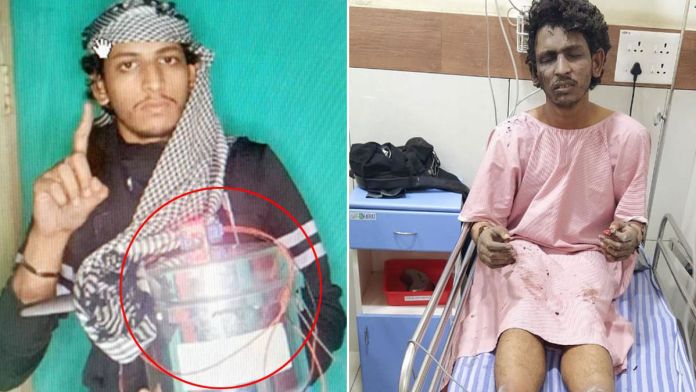While investigators think on the basis of their preliminary probe that Mohammed Shariq, the auto-rickshaw passenger whose bomb went off prematurely in Mangaluru, is associated with the Islamic States of Iraq and Syria (Isis), the dreaded terrorist organisation’s reach in the country is hardly tentative. Today, photos of Shariq in an ‘Isis-pose’, holding aloft a pressure cooker with circuit wires, surfaced.
Then, the Popular Front of India (PFI), banned recently by the government for alleged terrorist links and spreading communal hatred, has a “well-structured and organised” presence in the Gulf countries for raising and mobilising funds, the Enforcement Directorate (ED) said today after a local court took cognisance of its latest charge sheet filed against three PFI office bearers. The fundamental basis of the ban on PFI was its links with Isis.
Besides reports of Muslims from Kerala leaving their families and joining Isis arrive time and again, the National Investigation Agency (NIA) and the US State Department had hard evidence of many Isis operatives in the country.
In 2015, the Observer Research Foundation noted, “… Isis has no known operational base in Pakistan although there are stray reports about its presence. It can only operate in India if it has local logistic support both in Pakistan and India.” But in 2016, almost 30 Indians were reported to have left the country to join terrorist training camps run by Isis in the Middle East.
In 2017, the NIA released photos of 21 Isis cadres from Kerala, both men and women. All of them were from two districts in Kerala: Kasaragod and Palakkad. In 2019, four of these women were found in an Afghanistan jail. “The NIA investigation into these cases of missing girls unearthed diabolic nexus of love-jihad, radicalisation and conversions. And many of these targets were non-Muslim women,” reported The New Indian.
In between, in 2018, the NIA arrested 27-year-old Mohammed Riyaz of Kannur, accused by his wife to have converted her by force to despatch her to Isis as a sex slave.
As of 2020, the US State Department reported in “Country Reports on Terrorism” the existence of 66 Isis operatives in India, all Indian Muslims.
In August 2021, sources in intelligence agencies said the “rule of the Islamic Caliphate in India” was among the lofty ideological goals the Kabul bombers associated with the Isis-Khorasan were planning to work on. Another intelligence input suggested that Jaish-e-Mohammed after moving their base to Helmand, bordering Kandahar, Afghanistan, and the Lashkar-e-Taiba after switching to Kunar in the rocky country, had joined hands with Isis-K.
In February this year, at least 40 other Indian nationals, mostly comprising members of the diaspora in the Middle East, including women and children were reportedly found sheltered in al Shadadi and other Kurdish Syrian Democratic Forces-run camps like Ghweiran and al Hawl, as well as jails in Turkey and Libya.
That very month, the NIA filed a charge sheet in a special court in Bengaluru against eight individuals, including Deepthi Marla alias Mariyam, in connection with the Isis terrorist Kerala module case. The charge sheet named Mohammed Waqar Lone alias Wilson Kashmiri, Mizha Siddeeque, Shifa Haris alias Ayesha, Obaid Hamid Matta, Madesh Shankar alias Abdullah, Ammar Abdul Rahiman and Muzamil Hassan Bhat too.
In March, Abu Ibrahim al-Hanif, the emir of Isis in Bangladesh, said in an interview that the terrorist organisation wanted to liberate India from the mushikirin (disbelievers).
Then, following the Muslim outrage over BJP’s suspended spokesperson Nupur Sharma‘s historically and theologically accurate statement about Mohammed, Islam’s prophet, the Islamic State Khurasan Province began a news bulletin service through its mouthpiece al Azaim, where the first news bulletin was focused on India and the issue of blasphemy. Their videos showed houses of (riotous) Muslims bulldozed and older statements of the outfit’s suicide bombers who were Indian. They threatened to conduct attacks against India wherever possible.
In August, Russian security services detained an Isis terrorist who was planning an attack in India in response to the statement by Sharma. The terrorist was planning to attack “one of the representatives of the ruling circles of India”. The “ruling circle” was a reference to the ruling Bharatiya Janata Party.
On 20 October, the NIA conducted raids at two locations in Varanasi and Delhi in connection with the case of Isis’s ‘Voice of Hind’ module and arrested a 24-year-old radicalised man who was recruiting Indian youths on behalf of the terrorist organisation for waging war against the Indian state.
On 15 November (last week), Chennai Police conducted searches at locations of people suspected to be Isis sympathisers. Five days before that, the NIA had raided 40 places in Tamil Nadu to catch suspects with Isis links. That very day, Chennai Police tracked down three men who tried to avoid a checkpoint. One of the cops, who tried to stop them, got hold of their bag, which contained Isis leaflets and bomb schematic notes with details about chemicals required to create explosives allegedly taken from YouTube tutorial videos.
Isis remains a banned organisation in India since December 2014.



You must log in to post a comment.